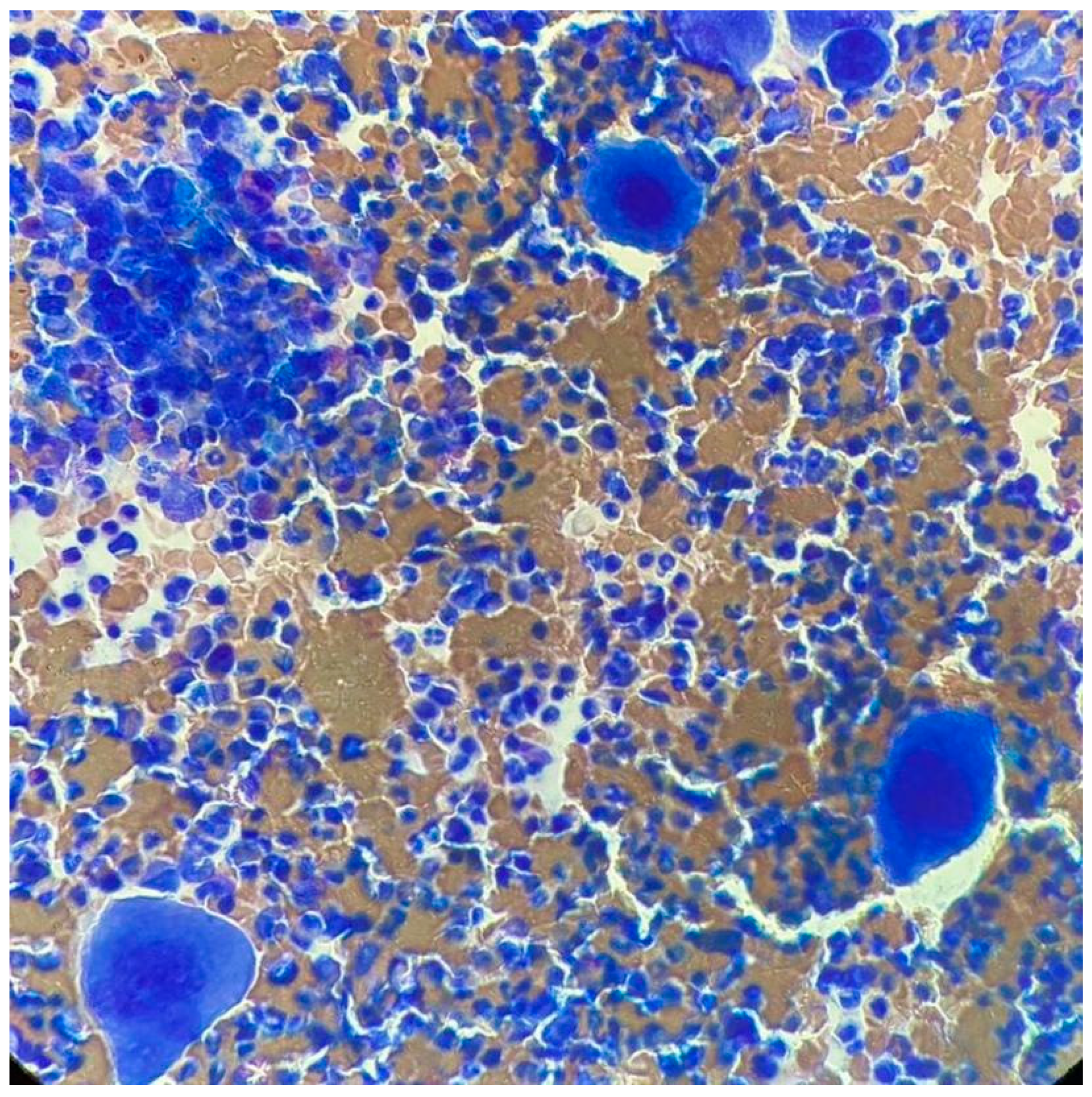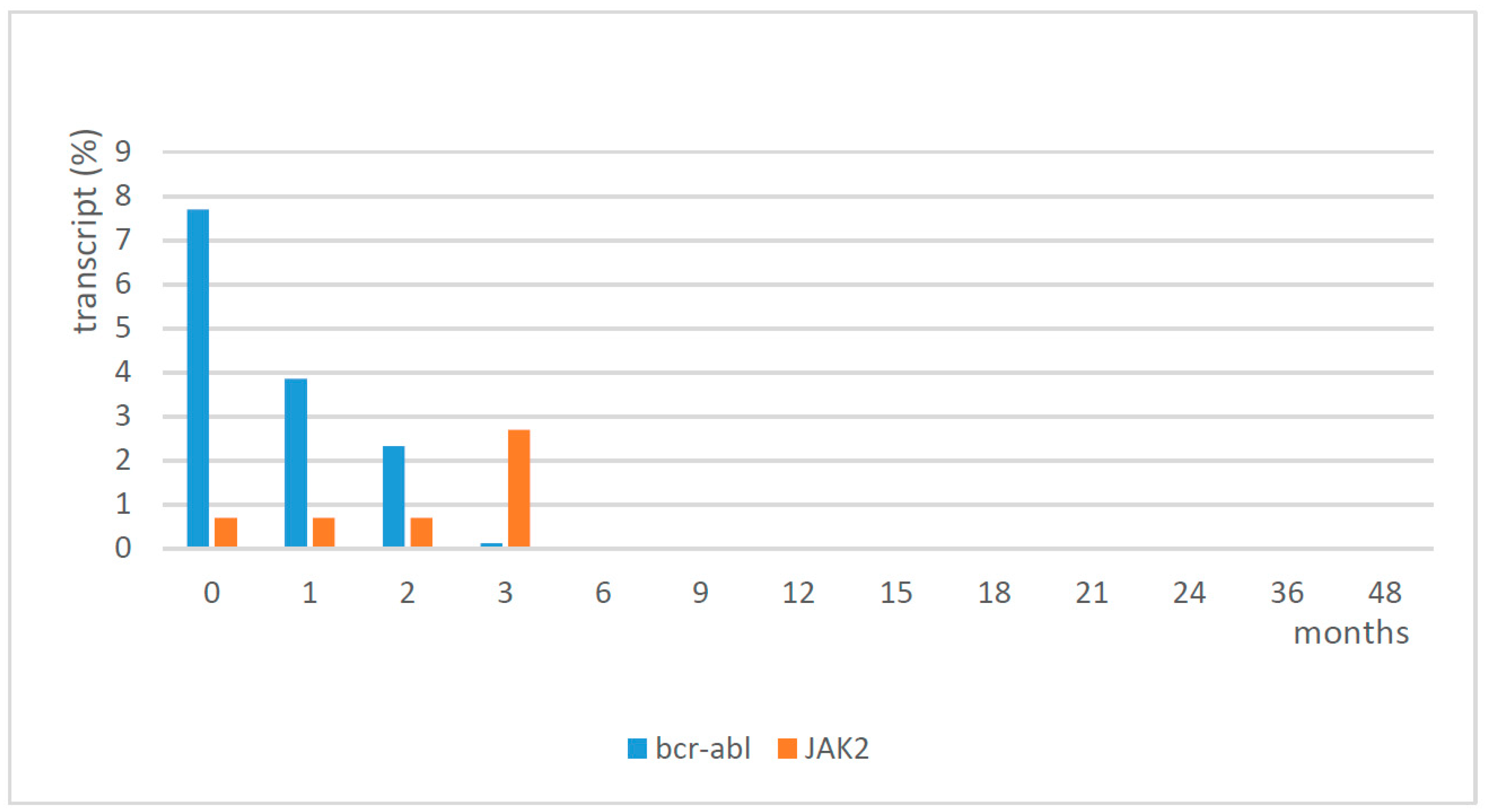Chronic Myeloid Leukemia in a Patient with Previous Idiopathic Thrombocytopenic Purpura: How to Manage Imatinib Together with Eltrombopag
Abstract
:1. Introduction
2. Case Report
3. Discussion
4. Conclusions
Author Contributions
Funding
Institutional Review Board Statement
Informed Consent Statement
Acknowledgments
Conflicts of Interest
References
- Rodeghiero, F. Immune thrombocytopenia in myeloid and lymphoid clonal disorders: An intriguing association. Haematologica 2021, 106, 1231–1233. [Google Scholar] [CrossRef] [PubMed]
- Jachiet, V.; Moulis, G.; Hadjadj, J.; Seguier, J.; Laribi, K.; Schleinitz, N.; Vey, N.; Sacre, K.; Godeau, B.; Beyne-Rauzy, O.; et al. Clinical spectrum, outcome and management of immune thrombocytopenia associated with myelodysplastic syndromes and chronic myelomonocytic leukemia. Haematologica 2021, 106, 1414–1422. [Google Scholar] [CrossRef] [PubMed]
- Hadjadj, J.; Michel, M.; Chauveheid, M.-P.; Godeau, B.; Papo, T.; Sacre, K. Immune thrombocytopenia in chronic myelomonocytic leukemia. Eur. J. Haematol. 2014, 93, 521–526. [Google Scholar] [CrossRef] [PubMed]
- Gao, Y.; Gong, M.; Zhang, C.; Kong, X.; Ma, Y. Successful eltrombopag treatment of severe refractory thrombocytopenia in chronic myelomonocytic leukemia: Two cases reports: A CARE-compliant article. Medicine 2017, 96, e8337. [Google Scholar] [CrossRef] [PubMed]
- Chu, J.Y.; Gale, G.B.; O’Connor, D.M.; Bouhasin, J.D.; Gallagher, N.I. Chronic idiopathic thrombocytopenic purpura followed by chronic myelocytic leukemia. Am. J. Pediatr. Hematol. Oncol. Spring 1981, 3, 83–85. [Google Scholar]
- Imashuku, S.; Morimoto, A.; Kuriyama, K.; Kano, G.; Hibi, S.; Todo, S. Chronic myeloid leukemia in a patient with chronic idiopathic thrombocytopenic purpura: Rapid response to imatinib mesylate (STI571). Med. Pediatr. Oncol. 2003, 41, 159–160. [Google Scholar] [CrossRef] [PubMed]
- Hattori, H.; Kuwayama, M.; Takamori, H.; Nishiura, N.; Karasuno, T. Development of chronic myelogenous leukemia during treatment with TPO receptor agonist for ITP. Rinsho Ketsueki 2014, 55, 2429–2432. [Google Scholar] [CrossRef] [PubMed]
- Aguiar, R.C.T. Therapy-Related Chronic Myeloid Leukemia: An Epidemiological, Clinical and Pathogenetic Appraisal. Leuk. Lymphoma 1998, 29, 17–26. [Google Scholar] [CrossRef] [PubMed]
- Autore, F.; Sorà, F.; Chiusolo, P.; Annunziata, M.; Iurlo, A.; Cattaneo, D.; Galimberti, S.; Bajer, J.A.; Sica, S. ‘Secondary chronic myeloid leukemia’: Comparison between patients previously exposed or not to chemo- and/or radiotherapy. Leuk. Lymphoma 2019, 60, 3584–3586. [Google Scholar] [CrossRef] [PubMed]
- Hochhaus, A.; Baccarani, M.; Silver, R.T.; Schiffer, C.; Apperley, J.F.; Cervantes, F.; Clark, R.E.; Cortes, J.E.; Deininger, M.W.; Guilhot, F.; et al. European LeukemiaNet 2020 recommendations for treating chronic myeloid leukemia. Leukemia 2020, 34, 966–984. [Google Scholar] [CrossRef] [PubMed] [Green Version]
- Iino, M.; Sakamoto, Y.; Sato, T. Treatment-free remission after thrombopoietin receptor agonist discontinuation in patients with newly diagnosed immune thrombocytopenia: An observational retrospective analysis in real-world clinical practice. Int. J. Hematol. 2020, 112, 159–168. [Google Scholar] [CrossRef] [PubMed]
- Lucchini, E.; Palandri, F.; Volpetti, S.; Vianelli, N.; Auteri, G.; Rossi, E.; Patriarca, A.; Carli, G.; Barcellini, W.; Celli, M.; et al. Eltrombopag second-line therapy in adult patients with primary immune thrombocytopenia in an attempt to achieve sustained remission off-treatment: Results of a phase II, multicentre, prospective study. Br. J. Haematol. 2021, 193, 386–396. [Google Scholar] [CrossRef] [PubMed]


| Days from Diagnosis | White Blood Cell (109/L) | Neutrophil Count (109/L) | Platelet Count (109/L) | Treatment |
|---|---|---|---|---|
| 0 | 25.9 | 21.3 | 800 | Start imatinib, stop eltrombopag |
| 7 | 21.8 | 17.9 | 620 | |
| 21 | 6.2 | 5.1 | 160 | |
| 35 | 5.0 | 3.2 | 60 | Start eltrombopag 25 mg every other day |
| 42 | 4.1 | 3.1 | 73 | Eltrombopag 25 mg/day |
| 49 | 4.2 | 3.0 | 149 | |
| 60 | 4.4 | 3.1 | 167 | |
| 90 | 4.1 | 2.9 | 156 |
Publisher’s Note: MDPI stays neutral with regard to jurisdictional claims in published maps and institutional affiliations. |
© 2021 by the authors. Licensee MDPI, Basel, Switzerland. This article is an open access article distributed under the terms and conditions of the Creative Commons Attribution (CC BY) license (https://creativecommons.org/licenses/by/4.0/).
Share and Cite
Autore, F.; Sora’, F.; Chiusolo, P.; Minnella, G.; Colangelo, M.; Rossi, E.; Sica, S. Chronic Myeloid Leukemia in a Patient with Previous Idiopathic Thrombocytopenic Purpura: How to Manage Imatinib Together with Eltrombopag. Medicina 2021, 57, 1326. https://doi.org/10.3390/medicina57121326
Autore F, Sora’ F, Chiusolo P, Minnella G, Colangelo M, Rossi E, Sica S. Chronic Myeloid Leukemia in a Patient with Previous Idiopathic Thrombocytopenic Purpura: How to Manage Imatinib Together with Eltrombopag. Medicina. 2021; 57(12):1326. https://doi.org/10.3390/medicina57121326
Chicago/Turabian StyleAutore, Francesco, Federica Sora’, Patrizia Chiusolo, Gessica Minnella, Maria Colangelo, Elena Rossi, and Simona Sica. 2021. "Chronic Myeloid Leukemia in a Patient with Previous Idiopathic Thrombocytopenic Purpura: How to Manage Imatinib Together with Eltrombopag" Medicina 57, no. 12: 1326. https://doi.org/10.3390/medicina57121326
APA StyleAutore, F., Sora’, F., Chiusolo, P., Minnella, G., Colangelo, M., Rossi, E., & Sica, S. (2021). Chronic Myeloid Leukemia in a Patient with Previous Idiopathic Thrombocytopenic Purpura: How to Manage Imatinib Together with Eltrombopag. Medicina, 57(12), 1326. https://doi.org/10.3390/medicina57121326






